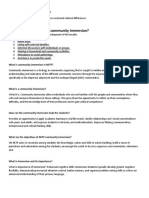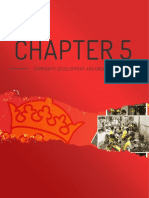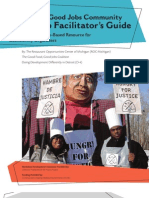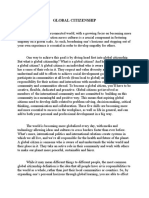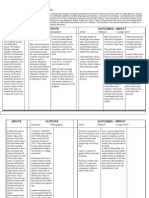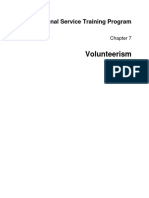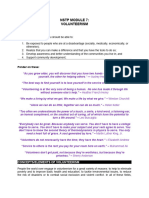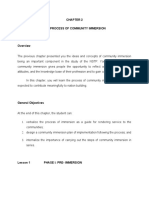Global Perspective
Global Perspective
Uploaded by
Margare LuyonCopyright:
Available Formats
Global Perspective
Global Perspective
Uploaded by
Margare LuyonOriginal Description:
Copyright
Available Formats
Share this document
Did you find this document useful?
Is this content inappropriate?
Copyright:
Available Formats
Global Perspective
Global Perspective
Uploaded by
Margare LuyonCopyright:
Available Formats
The Benefits of a Global Perspective
Bonnie Koenig
INTRODUCTION BENEFITS TO A MORE GLOBAL
Two recent trends that are affecting PERSPECTIVE
society at large are also having. an effect There are many benefits to incorporat-
on the volunteer community. Being pre- ing a more global perspective into your
pared for these changes as a volunteer own leadership approach. Some of these
administrator can help you to address include:
them effectively and may even provide an
increased depth to your program. These 1. Understanding and appreciating the
two trends are: 1) The increasing multi- strengths of different cultures can help
culturalism of the work force and 2) The you to better understand those who
increasing impact of the world on indi- currently volunteer for your program
vidual countries and our local activities. who may have a different cultural
Although the concept of multicultural- background than you.
ism (varied cultures within one country) 2. Understanding and appreciating differ-
is not completely the same as multina- ent cultures can help to increase the
tionalism (cultural distinctions as they quality of service you provide.
arise around the world) there are many 3. Reaching out to other cultures may
similarities in how one approaches a sen- expand your customer service base by
sitivity to and appreciation of differing making your programs more attractive
cultures. As the understanding of one can or effective.
certainly enhance your ability to under- 4. Reaching out to those from other cul-
stand the other, in this short article (which tures can expand the employee or other
is designed to raise some preliminary pool of people available to volunteer
ideas that you may want to explore fur- for your program.
ther vis-a-vis your own organization's 5. Learning about and trying different
volunteers), I will be addressing them approaches can supply a variety of
together by focusing on common factors. options for resolving problems or chal-
I will refer to this as developing a "global lenges.
perspective", or a looking outward into 6. Lessons learned from colleagues in
the world for perspectives that can other countries dealing with similar
enhance your local programs. challenges can provide additional
BonnieKoenigis a consultant working with nonprofit organizations on developing their international programs.
She has worked with local, national and international organizations in the areas of strategic planning, organiza-
tional and program development, staff training, membership expansion and international meeting planning.
Prior to beginning her consulting practice she was the executive director of Zonta International, a women's ser-
vice organization with members (doing volunteer activities) in 65 countries, and the Council of Great Lakes Gov-
ernors which worked closely with the neighboring Canadian provinces. She is the author of the recent articles
"Taking your organization international" and "The Fine Art of Meeting Pl~ning" in Nonprofit World and "The
Management of International NGOs" in Transnational Associations, as well as co-developer of a web site for the
American Society of Association Executives to help associations find resources on international programs. Ms.
Koenig has lived in Australia, France and Mauritania, West Africa, and has traveled to over 20 countries.
THE JOURNAL OF VOLUNTEER ADMINISTRATION 43
Spring2000
know ledge to strengthen your own themselves may remain hidden.
programs. One of our best tools is often that of
Some considerations when developing observation and being willing to try new
an international program or building things. Kofi Annan, the Secretary General
your own global perspectives skill set of the United Nations who was born in
To understand other cultures and build the African country of Ghana tells the
relationships of trust takes time and gen- story of coming to the United States as a
uine commitment. The results of your student and experiencing his first Min-
efforts may only be seen in the long term, nesota winter. At first he shunned some-
especially if you are dealing with individ- thing used by his fellow students to brave
uals who are not familiar with the 'way of the cold: earmuffs. But he soon learned an
doing business' that is practiced in the important lesson. "Never walk into an
U.S. You may find that they will not want environment and assume you understand
to rush the relationship. it better than the people who live there,"
Concepts of volunteerism vary around Annan later commented.
the world. Do not assume that someone The story of Kofi Annan also illustrates
from another culture shares your concept another truism about being successful in
of volunteerism. Take time to clarify what dealing with a multicultural or multina-
you are expecting of the volunteers who tional environment: try to understand
are part of your program and to under- first before rushing to judgement. We all
stand their expectations. have our own perspectives on how the
You may want to learn more about world 'should' operate, and we are often
other cultures/nationalities, especially of quick to judge others by the only stan-
the volunteers you manage. Working with dards we may know. Take the time to
those of other nationalities or cultures is understand why someone may be
about more than just understanding approaching a situation differently than
another language. According to Varner you do - you may learn something help-
and Beamer in their book Intercultural ful!
Communicationin the GlobalWorkplace,"In Remember that seemingly little things
order to understand the significance of can make a difference - pronouncing
the message from someone, you need to names correctly or using appropriate
understand the way that person looks at titles or salutations. Many cultures are
the world and the values that weigh heav- very formal - if you start off a new rela-
ily in that person's cultural backpack. You tionship formally you can always make it
need to understand the meanings that are more informal when it seems appropriate
not put into words, the importance of the to do so. But if you start off too informal-
words that are used, and the way the mes- ly it may make a bad first impression that
sage is organized and transmitted." may be hard to correct.
As a leader, incorporating varying
approaches into your programs and/ or CULTURAL VARIANCES ON
management style can make those who VOLUNTEERING
may first be uncomfortable in your envi- First endeavor to understand your own
ronment feel more at ease. Don't assume culture as a basis of comparison for
others know what you mean or you know understanding others. For example, the
what someone else means - when in U.S. is a very individualistic nation -
doubt explain or ask questions. For exam- personal property, freedom of speech, and
ple, in many Asian cultures it is polite to rights of minorities are all concepts to pre-
describe one's abilities in modest ways. If serve the individual within a society. The
these words are taken at face value and individual is seen as the responsible party
not probed deeper, the skills and and individuals (working within organi-
strengths of the individuals describing zations) also choose whether or not to vol-
44 THEJOURNALOF VOLUNTEER
ADMINISTRATION
Spring 2000
unteer their time. Many other societies through partnering with a group outside
place a higher priority on the collective of your home country or "lessons. to be
and are willing to give up some individ- learned" from other countries that may
ual rights for the benefit of the collective. help to strengthen your local program.
Where a country is on this spectrum will The U.S. Agency for International
also affect the approach to volunteerism. Development (USAID) recognized this
A few examples: idea and began a program called
• Many cultures have no direct, equiva- "Lessons Without Borders" to share some
lent term for volunteering. Unpaid of the good ideas used in projects they
work may be bound up with notions of funded in other countries back in the U.S.
community obligation. A New Zealand USAID and international development
Maori quote points out, "You know workers in general work in countries
your place and contribute accordingly." where resources are scarce, and therefore,
• In the Muslim world, volunteering is they have had to develop creative, low
often linked to the religious and spiri- cost ways to achieve their goals. Lessons
tual belief in charity. This often trans- Without Borders tries to remind those in
lates into compassion for the most vul- the U.S. of what they already know, but
nerable in society and an obligation to sometimes forget, and reinforces the back
help. to basics approach to solving problems.
• In Latin America, voluntary action has Management Sciences for Health based
been a common feature since colonial in Boston is an example of an organiza-
times, often tied into the Catholic tion that has taken the USAID strategy of
Church. The social welfare organiza- looking for ways to utilize the lessons it
tion, funded through religious channels has learned in working overseas back in
but administered by laymen, is often a the health care community in the U.S. Its
common model. U.S. programs have focused in the follow-
ing areas:
For another perspective on volunteer-
ing, in Russia and other countries that 1. Utilizing the members of the local com-
were part of the former Soviet Union, one munity to provide health care educa-
of the legacies of the decades of Soviet tion, including using part-time commu-
influence has been a perspective that the nity volunteers to supplement the work
"state" provides. Thus in some areas, the of full-time professionals.
concept of the need to volunteer to help 2. Matching the work of health care pro-
the community is less common than in fessionals in developing countries to
other communities. The role of nonprofit the needs of immigrant populations
organizations and volunteerism is now from the same country that now reside
often seen as important to enhancing the in the U.S. This has included sponsor-
public discussion and participation that ing a series of conferences with speak-
can encourage poorly functioning state ers from other countries.
institutions to become more responsive 3. Strengthening management systems
and accountable. based on techniques that were devel-
oped overseas but that are applicable to
KEEPING TRACK OF U.S. community-based health care
INTERNATIONAL TRENDS groups.
In addition to taking the time to get to
know the cultural attributes that volun- Some ideas on how to keep track of inter-
teers in your program may have, there are national trends:
also advantages to keeping track of inter-
national trends. For example, there may 1) One easy step is to learn about the cul-
be opportunities for your program tures of the volunteers who are part of
THE JOURNAL OF VOLUNTEER ADMINISTRATION 45
Spring 2000
your program or the communities you Sustaining Civil Society:Strategies for
serve. Consider holding a brown bag ResourceMobilization, edited by Leslie
lunch discussion or other forums for M. Fox and S. Bruce Schearer, CIVI-
the informal exchange of ideas. CUS, 1997, Washington, D.C.
2. Attend meetings with international Varner, Iris and Beamer, Linda, 1995,
attendees and seek out attendees from InterculturalCommunicationin the Global
other countries. Ask questions about Workplace,Boston, Irwin Publications
their work and how they approach sim-
ilar challenges.
3. Participate on listservs (electronic dis-
cussion groups) with international par-
ticipants. The growth of e-mail and the
Internet has made it possible for practi-
tioners (such as volunteer administra-
tors) around the world to communicate
easily with each other. One example is
a group on volunteer management
CYBERVPM which can be found at
http://www.charitychannel.com
4. Look at websites that cover internation-
al themes in your interest area. The
United Nations International Year of
the Volunteer site at http:/ /www.
iyv2001.org would be an example.
CONCLUSION
First and foremost developing a global
perspective is an attitude. It is an under-
standing that there are varying and equal-
ly valuable approaches to many different
activities, including volunteering. Once
you have this mindset, investing some
time in keeping yourself informed as to
the global perspectives around you will
begin to come naturally and the rewards
will become obvious.
REFERENCES
"Alliance: Building Resources for the
Community Worldwide", CharitiesAid
Foundation,Volume 5, #1, March 2000,
and Volume 4, #2, June 1999, Kent,
United Kingdom
Culturegram series, Brigham Young Uni-
versity, David M. Kennedy Center for
International Studies, Provo, Utah (4
page country write-ups available for
over 100 countries).
46 THE JOURNAL OF VOLUNTEER ADMINISTRATION
Spring2000
You might also like
- SALVAÃ As Researched Group5 Community Immersionwith 20 Items Quiz.Document6 pagesSALVAÃ As Researched Group5 Community Immersionwith 20 Items Quiz.Andrea D. Salvaña100% (1)
- Topic 7 - Volunteerism Module 1Document9 pagesTopic 7 - Volunteerism Module 1Benjamin GabrielNo ratings yet
- Participatory Planning and Action HandbookDocument63 pagesParticipatory Planning and Action HandbookBarbara Khavugwi MakhayaNo ratings yet
- Chapter 5 - Community Development and OrganizingDocument17 pagesChapter 5 - Community Development and OrganizingElaine DiazNo ratings yet
- ROC Facilitator's GuideDocument12 pagesROC Facilitator's GuideprogressmichiganNo ratings yet
- Chapter 5 Eread PDFDocument17 pagesChapter 5 Eread PDFkrista del rosarioNo ratings yet
- NSTP Module FinalDocument60 pagesNSTP Module Finalpia.longnoNo ratings yet
- Freirian FacilitatorsDocument21 pagesFreirian Facilitatorsidelin.molinasNo ratings yet
- AFS Foundations Handbook - FinalDocument41 pagesAFS Foundations Handbook - FinalJoão RochaNo ratings yet
- Cross Culture ModuleDocument7 pagesCross Culture ModuleChetan NarkhedeNo ratings yet
- Comhlámh's Volunteer CharterDocument34 pagesComhlámh's Volunteer Charterforum-idsNo ratings yet
- Global CitizenshipDocument5 pagesGlobal CitizenshipBianca VacunawaNo ratings yet
- Activity No. 12 - Citizenship EducationDocument3 pagesActivity No. 12 - Citizenship EducationALYSSA NICOLE GINESNo ratings yet
- Informal Ethnography Final DraftDocument5 pagesInformal Ethnography Final Draftapi-546283294No ratings yet
- Chapter 3 Co-Creating With The CommunityDocument26 pagesChapter 3 Co-Creating With The CommunityRamona Isabel UrsaisNo ratings yet
- Ust NSTP E-Read Chapter5Document20 pagesUst NSTP E-Read Chapter5Jaica Mangurali TumulakNo ratings yet
- World Cultures 5Document3 pagesWorld Cultures 5jimbecker1961No ratings yet
- 1 P Revisiting Key Concepts From NSTP 1 1Document4 pages1 P Revisiting Key Concepts From NSTP 1 1Janna abegail BarrionNo ratings yet
- Ust NSTP E-Read Chapter5Document19 pagesUst NSTP E-Read Chapter5Mark PuaNo ratings yet
- Week 19 Community Service VolunteerismDocument4 pagesWeek 19 Community Service VolunteerismKlevien MabaitNo ratings yet
- CHAPTER 7 VolunteerismDocument7 pagesCHAPTER 7 VolunteerismDracule MihawkNo ratings yet
- Janiela A. de Vera Activity 3 For NSTP 2: InfluencersDocument2 pagesJaniela A. de Vera Activity 3 For NSTP 2: InfluencersNye laNo ratings yet
- Diversity in The WorkplaceDocument7 pagesDiversity in The Workplacetheobaudin123No ratings yet
- Assignment 5Document6 pagesAssignment 5api-282959207No ratings yet
- PIH RecsDocument44 pagesPIH Recsealawton4No ratings yet
- Understanding The Concepts and Principles of Community ImmersionDocument9 pagesUnderstanding The Concepts and Principles of Community ImmersionJulie RamosNo ratings yet
- 7 NSTP 1 Volunteerism Prefi 2Document5 pages7 NSTP 1 Volunteerism Prefi 2jandob.eduNo ratings yet
- Submitted To: Submitted By:: Prof. Luxmi Malodia Manpreet Kaur (12) Mugdhaa (13) NareshDocument40 pagesSubmitted To: Submitted By:: Prof. Luxmi Malodia Manpreet Kaur (12) Mugdhaa (13) NareshManpreet KaurNo ratings yet
- Lesson 3 - VolunteerismDocument24 pagesLesson 3 - Volunteerismangeloumali42No ratings yet
- FORUM Discussion Paper 2009 Volunteers Catalysts For Social EngagementDocument25 pagesFORUM Discussion Paper 2009 Volunteers Catalysts For Social Engagementforum-idsNo ratings yet
- Towards The Global Living - MunifDocument18 pagesTowards The Global Living - MunifMunif TokNo ratings yet
- Lesson 2 People Centered Development Management and EmpowermentDocument3 pagesLesson 2 People Centered Development Management and EmpowermentMr.UnknownNo ratings yet
- Idp 2015-09 L AshworthDocument20 pagesIdp 2015-09 L Ashworthapi-272013505No ratings yet
- Introduction To NstpiiDocument15 pagesIntroduction To NstpiiSIJINo ratings yet
- AFS Student Educational Goals April 2016 PDFDocument2 pagesAFS Student Educational Goals April 2016 PDFAnonymous F7pEFWNo ratings yet
- Managing Across CulturesDocument8 pagesManaging Across Cultures[••]No ratings yet
- IVCO 2008 Volunteer Charter TextDocument19 pagesIVCO 2008 Volunteer Charter Textforum-ids100% (2)
- VolunteerismDocument19 pagesVolunteerismtabaloika0No ratings yet
- Understanding Community and Immersion: Flordelis A. SedoDocument32 pagesUnderstanding Community and Immersion: Flordelis A. SedoKevin kurt IntongNo ratings yet
- Las Learning Acitivity Sheet Week: Department of EducationDocument21 pagesLas Learning Acitivity Sheet Week: Department of EducationRuben Sosing Leyba100% (2)
- Chapter 2 - Globalization, Diversity and EthicsDocument10 pagesChapter 2 - Globalization, Diversity and EthicsPhee JhayNo ratings yet
- Chapter 2 - Globalization, Diversity and EthicsDocument12 pagesChapter 2 - Globalization, Diversity and EthicsTrixxie mae MontelloNo ratings yet
- Human Resource Management: Submitted To: Submitted byDocument40 pagesHuman Resource Management: Submitted To: Submitted byManpreet Kaur100% (1)
- The Ear of The Leader Must Ring With The Voices of The PeopleDocument10 pagesThe Ear of The Leader Must Ring With The Voices of The PeopleHina Safarish GillNo ratings yet
- NSTP 2 Chapter 2-3 2021-2022Document52 pagesNSTP 2 Chapter 2-3 2021-2022Karen Pearl BayubayNo ratings yet
- NAEA - Getting Started With Equity, Diversity, and InclusionDocument7 pagesNAEA - Getting Started With Equity, Diversity, and InclusionMay BuraikNo ratings yet
- Leader: Reyes, Jenny Members:: Nasser, Norhanah Orquia, Simon Omotoy, Jervis Palpalatoc, Nica Raagas, MaybelynDocument26 pagesLeader: Reyes, Jenny Members:: Nasser, Norhanah Orquia, Simon Omotoy, Jervis Palpalatoc, Nica Raagas, MaybelynDanielle May ReginaldoNo ratings yet
- Global MindsetDocument1 pageGlobal Mindsetkong_yau_2No ratings yet
- Why You Should Organize A Debate SocietyDocument18 pagesWhy You Should Organize A Debate SocietyEJ FabrigaNo ratings yet
- FreeTraining InterculturallyCompetentU WorkbookDocument8 pagesFreeTraining InterculturallyCompetentU WorkbookMarysia JasiorowskaNo ratings yet
- The Process of Community ImmersionDocument9 pagesThe Process of Community ImmersionNobody but youNo ratings yet
- Mini D Skill Development FinalDocument6 pagesMini D Skill Development Finalapi-301683026No ratings yet
- Booklet Communication For NGOs PDFDocument39 pagesBooklet Communication For NGOs PDFAdriana EneNo ratings yet
- Procedures/Steps in Making Community Extensions or Outreach ProgramsDocument2 pagesProcedures/Steps in Making Community Extensions or Outreach ProgramsjevvNo ratings yet
- NSTP 2Document6 pagesNSTP 2Hes Jhen BarrioNo ratings yet
- Community Mobilization Workshop - Slides For Sharing - Day 1Document39 pagesCommunity Mobilization Workshop - Slides For Sharing - Day 1Eng Abdulkadir MahamedNo ratings yet
- We Do Know How: A Buyer-Led Approach to Creating Jobs for the PoorFrom EverandWe Do Know How: A Buyer-Led Approach to Creating Jobs for the PoorNo ratings yet
